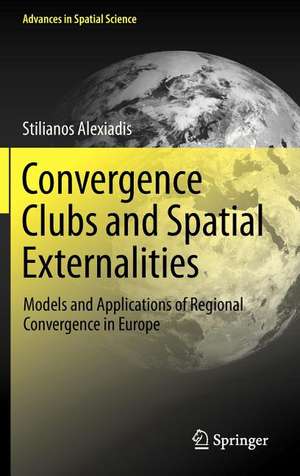Convergence Clubs and Spatial Externalities: Models and Applications of Regional Convergence in Europe: Advances in Spatial Science
Autor Stilianos Alexiadisen Limba Engleză Hardback – 26 sep 2012
| Toate formatele și edițiile | Preț | Express |
|---|---|---|
| Paperback (1) | 638.57 lei 6-8 săpt. | |
| Springer Berlin, Heidelberg – 15 oct 2014 | 638.57 lei 6-8 săpt. | |
| Hardback (1) | 640.88 lei 6-8 săpt. | |
| Springer Berlin, Heidelberg – 26 sep 2012 | 640.88 lei 6-8 săpt. |
Din seria Advances in Spatial Science
-
 Preț: 368.92 lei
Preț: 368.92 lei - 18%
 Preț: 963.47 lei
Preț: 963.47 lei - 18%
 Preț: 948.16 lei
Preț: 948.16 lei - 18%
 Preț: 947.67 lei
Preț: 947.67 lei - 18%
 Preț: 940.72 lei
Preț: 940.72 lei - 18%
 Preț: 954.45 lei
Preț: 954.45 lei - 15%
 Preț: 646.62 lei
Preț: 646.62 lei - 18%
 Preț: 959.50 lei
Preț: 959.50 lei - 18%
 Preț: 956.33 lei
Preț: 956.33 lei - 18%
 Preț: 949.23 lei
Preț: 949.23 lei - 15%
 Preț: 646.75 lei
Preț: 646.75 lei - 15%
 Preț: 643.99 lei
Preț: 643.99 lei - 18%
 Preț: 955.40 lei
Preț: 955.40 lei - 15%
 Preț: 643.00 lei
Preț: 643.00 lei - 15%
 Preț: 644.49 lei
Preț: 644.49 lei - 18%
 Preț: 953.35 lei
Preț: 953.35 lei - 18%
 Preț: 956.03 lei
Preț: 956.03 lei - 15%
 Preț: 647.27 lei
Preț: 647.27 lei - 15%
 Preț: 638.24 lei
Preț: 638.24 lei - 18%
 Preț: 961.23 lei
Preț: 961.23 lei - 18%
 Preț: 954.93 lei
Preț: 954.93 lei - 15%
 Preț: 643.48 lei
Preț: 643.48 lei - 18%
 Preț: 955.70 lei
Preț: 955.70 lei - 15%
 Preț: 650.86 lei
Preț: 650.86 lei - 15%
 Preț: 650.04 lei
Preț: 650.04 lei - 15%
 Preț: 648.42 lei
Preț: 648.42 lei - 18%
 Preț: 949.42 lei
Preț: 949.42 lei - 18%
 Preț: 960.30 lei
Preț: 960.30 lei - 18%
 Preț: 948.29 lei
Preț: 948.29 lei - 18%
 Preț: 958.07 lei
Preț: 958.07 lei - 18%
 Preț: 950.66 lei
Preț: 950.66 lei - 18%
 Preț: 956.03 lei
Preț: 956.03 lei - 15%
 Preț: 643.65 lei
Preț: 643.65 lei - 18%
 Preț: 956.99 lei
Preț: 956.99 lei - 18%
 Preț: 956.81 lei
Preț: 956.81 lei - 18%
 Preț: 958.73 lei
Preț: 958.73 lei - 18%
 Preț: 959.98 lei
Preț: 959.98 lei - 18%
 Preț: 952.40 lei
Preț: 952.40 lei - 15%
 Preț: 643.00 lei
Preț: 643.00 lei
Preț: 640.88 lei
Preț vechi: 753.97 lei
-15% Nou
Puncte Express: 961
Preț estimativ în valută:
122.64€ • 131.14$ • 102.25£
122.64€ • 131.14$ • 102.25£
Carte tipărită la comandă
Livrare economică 18 aprilie-02 mai
Preluare comenzi: 021 569.72.76
Specificații
ISBN-13: 9783642316258
ISBN-10: 3642316255
Pagini: 320
Ilustrații: XIV, 246 p.
Dimensiuni: 155 x 235 x 23 mm
Greutate: 0.43 kg
Ediția:2013
Editura: Springer Berlin, Heidelberg
Colecția Springer
Seria Advances in Spatial Science
Locul publicării:Berlin, Heidelberg, Germany
ISBN-10: 3642316255
Pagini: 320
Ilustrații: XIV, 246 p.
Dimensiuni: 155 x 235 x 23 mm
Greutate: 0.43 kg
Ediția:2013
Editura: Springer Berlin, Heidelberg
Colecția Springer
Seria Advances in Spatial Science
Locul publicării:Berlin, Heidelberg, Germany
Public țintă
ResearchCuprins
Preface.- 1 Introduction.- 2 Neoclassical and Post-Keynesian Theories of Regional Growth and Convergence/Divergence.- 3 'Endogenous Growth Theory' and 'New Economic Geography'.- 4 Club Convergence.- 5 Empirical Measure of Regional Convergence.- 6 EU-27 Regions: Absolute or Club Convergence? 7 'Club Convergence': Geography, Externalities and Technology.- 8 Conclusions.- Appendices.- References.
Notă biografică
Stilianos Alexiadis is researcher in the Ministry of Rural Development & Foods of Greece, Department of Agricultural Policy & Documentation. He received a PhD from Manchester Metropolitan University and published extensively on topics of regional growth, technology and convergence.
Textul de pe ultima copertă
Do dynamic externalities, in the form of technology creation, adoption and spatial agglomeration shape the pattern of regional growth in Europe? This study provides an alternative view on regional convergence. A model is developed which attributes club-convergence to existing differences with respect to the degree of technology adoption. In the first instance, empirical results suggest that the NUTS-2 regions of the EU-27 converge at a very slow rate. Further tests, however, indicate that convergence is restricted to a specific subset of regions. Such conclusions are tested further, using an alternative model of club-convergence, which incorporates the impact of spatial interaction, agglomeration externalities and technology. This shows that the convergence-club in Europe follows a certain geographical pattern and all members share similar characteristics regarding technology creation and adoption, and agglomeration externalities.
Caracteristici
Provides a review of the theoretical and empirical literature on regional convergence One of few books devoted exclusively to regional convergence Planners, policy-makers and regional development institutions in the EU can easily apply the models/methods described and conduct policy experiments?











